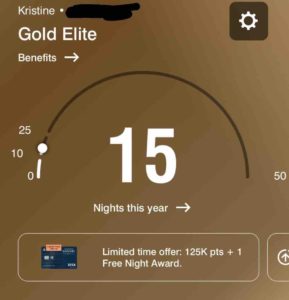There’s a term thrown around quite a bit in the points and miles world these days called “Player 2 or P2”. Have you heard of it? I’m not sure who exactly coined that phrase but, that term has stuck. To be quite honest I don’t love the term but that may be because I never got into video games…
What is Player 2?
Player 2 or Player 2 Mode or P2 refers to the second person in the points/miles earning team. Using Player 2 mode means you’re earning points/miles as a team. (Note you could expand your team to 3, 4, etc. people if you really wanted to!) Some people “play” with their spouse and their spouse serves as Player 2. That means they can access more points/miles than they could if they were “playing” alone. (Sounds weird to phrase it as playing with your spouse, but you get my point!).
A lot of times, the Player 2 really doesn’t care about the points and miles game and isn’t making the points/miles decisions, they’re just opening new credit cards and transferring points when Player 1 asks them to. Player 2 can be the more passive player. But others, such as Nate and I are very much a decision-making team when it comes to our points and miles strategy so it’s not like one person plays as Player 1 or Player 2 all of the time, it will vary.
What are the benefits of player 2 mode?
Having two people applying for credit cards and earning the welcome points can double your welcome bonus! So instead of earning 50,000 points on a welcome bonus, your team is really earning 100,000 points. In addition, you could end up with double the rewards when it comes to free nights or certificates. Many hotel credit cards come with several free nights, so now you’re not getting 5 free nights, as a team you’re getting 10. Another benefit of applying for the same credit card is that you could refer each other and earn the referral points. So instead of applying at the exact same time, have one person apply, get the card, then apply using their referral link.
For example, a card could have a 60,000 points welcome bonus and a 20,000 referral bonus. Player 1 opens up the card and gets the 60,000 welcome bonus points (once they’ve met the minimum spend requirement), then refers player 2 to the card.
Once player 2 is approved for the card, player 1 gets the 20,000 point referral bonus. Then, player 2 meets their minimum spend and they also get the 60,000 welcome bonus. Now the team has a total of 140,000 points that they can use for travel!

Now, I’m not suggesting you should apply for duplicate cards all the time or ever, it may not make sense for YOU/your team.
Different Cards
Another benefit of having a player 2 is that instead of opening the same card, you can diversify your credit card portfolio. Player 1 could have 5 completely different cards as Player 2 giving your team access to multiple reward options for hotel and airlines. For example, you may have one person be the Hilton card person and the other be the Marriott card person. This can help get your team more points/options without one person opening too many new cards and keep both members under the 5/24 rule. (click here to read more about the 5/24 rule from Upgraded Points)
How do you combine your points?
There are a few different ways to combine points/miles but it will depend on the program. For example, AMEX does not let you transfer points to another AMEX account. However, you can transfer AMEX points to one of their transfer airline account. AMEX also lets you transfer not just to your airline account but also to your spouse or partner as long as you’ve been an authorized user on the card for at least 90 days. For example, I could transfer my AMEX points to my husband’s Avianca LifeMiles account and then we could have a bigger pool of Avianca miles to book business class seats or roundtrip economy together. Chase offers a similar structure in that they will let you transfer your points to another person’s account as long as they live with you and are an authorized user on the card being used. Capital One allows you to share your reward points with anyone else with a capital one account. Although it’s much easier to share points between spouses/partners, depending on the reward account it is possible to share with family/friends.
What are the downsides?
Minimum Spend
Well, in order to qualify for those new credit card welcome bonus points there is typically a minimum spend required, that may be for example $4000 in 3 months. So now you and your player 2 need to spend $8000 to qualify if you’re both opening a new card. Depending on your spending, that may be difficult to do.
It might be better to stagger opening these cards instead of opening them at the same time or very close together so you focus on meeting the minimum spend on one card, then move to the other one. (There are also buying groups you can look into for additional spend) Just remember for planning purposes, you will not get the welcome bonus points until after you meet the minimum spend.
Annual fees
Another thing to keep in mind are the card annual fees, if a card has a $95 annual fee and you have two, then your team is really paying $190 per year. The fee is typically waived for the first year but after that you’ll need to decide if you want to keep the card and pay the annual fee or ask for a retention offer. With a retention offer the credit card company could offer you a reduced fee or additional points to get you to keep the card. That’s not always the case but it’s worth a shot to ask! Remember that even though the card has an annual fee the fee could pay for itself with the benefits it offers.
Trasnfer fees
Some cards will charge a fee to transfer points, so it’s important to have a strategy before opening a new card. Those transfer fees could eat into the value of the points you’re trying to transfer. If you’re planning to open a card and transfer the points to another card holder or account, make sure to research this first.
Non-Credit Card Points
Credit Card points are not the only thing that can be transferred to your Player 2. It’s possible to pool hotel points between your team. Some hotel chains make this easier than others. For example, Marriott allows you to transfer up to 100,000 points per year with another member. This is something we always take advantage of as it’s better to book using the person with the highest status account for upgrades and yearly qualification. Hilton has a much more generous policy and allows you to transfer up to 500,000 points per year to a family member or friend. Both Hilton and Marriott allow you to transfer these points for free, whereas IHG charges a fee to transfer between accounts. Sometimes even with the fee it’s still worth it to transfer.


Airline miles can also be transferred to another account holder. Most airlines do charge a transfer fee but also charge a processing fee as well. These can quickly add up so make sure to read the terms and conditions before making a request to transfer. For example, currently American Airlines charges about $35 per 1,000 miles but the rate varies and decreases the more miles you share. It may make sense/be cheaper to buy miles directly from the airline instead of transferring them. Southwest on the other hand charges $5/500 points and no processing fee to complete the points transfer. Very important to do the math!
Jetblue is the friendliest airline for points pooling as it actually allows TrueBlue members to pool their points with up to 6 other people.
Things to keep in mind
Before just applying for every card out there, come up with a strategy that works for your team. What is it that you’re trying to do? Do you have trips in mind you’re saving up for? Are you more interested in hotel or airline miles? This is where reaching out to points/miles experts for a one on one session can help!
LIKE US 🙂








